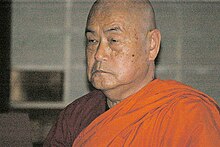Surai Sasai
Bhadant Nagarjun Surai Sasai | |
|---|---|
 Surai Sasai (7 June 2009) at Tokyo | |
| Born | 30 August 1935 |
| Other names | Bhadant Sasai |
Bhadant Nagarjun Arya Surai Sasai (佐々井 秀嶺, Sasai Shūrai) (born Minoru Sasai (佐々井 実, Sasai Minoru)), popularly known as Sasai, is a Japanese-born Buddhist bhikkhu (monk) who later chose India as his home. Susai came to India in 1966 and met Nichidatsu Fujii, whom he helped with the Peace Pagoda at Rajgir. He fell out with Fuji, however, but he related that on his return journey he was stopped by a dream in which a figure resembling Nagarjuna appeared and said, "Go to Nagpur". In Nagpur, he met Wamanrao Godbole, the person who had organized the conversion ceremony for Dr. Ambedkar in 1956. Sasai claims that when he saw a photograph of Dr. Ambedkar at Godbole's home, he realized that Ambedkar had appeared in his dream. At first, Nagpur residents considered Surai Sasai very strange. Then he began to greet them with "Jai Bhim" (victory to Ambedkar) and to build viharas. In 1987, a court case to deport him for overstaying his visa was dismissed. He was granted Indian citizenship, which cost him his Japanese citizenship. Sasai is one of the main leaders of the campaign to free the Mahabodhi Temple at Bodh Gaya from Hindu control.[1]
Disciples
Sasai has hundreds of thousands of lay disciples and hundreds of ordained monk and novice disciples. His most active disciples are Bhante Bodhi Dhamma (Dhammaji), Prajnasheela Bhikkhu, Ken Bodhi, and Bhikkhu Abhaya Putra. The first and last were trained as Theravada monk and the others as Mahayana monks. Bodhi Dhamma works in South India teaching Zen while Prajnasheela works in central India. Abhaya Putra is the founder of Metta India and trains Theravadin monks and novices of Indian origin in Thailand[2]
Timeline
- 1935 : Born in Sugao Niimi, Okayama Prefecture, the eldest of the brothers
- 1951 : Student Academy of positive 入塾 Tokyo.
- 1957 : High School Yoneko Aduma Tottori Prefecture. 大善寺 trained in Koshu City, Yamanashi Prefecture.
- Takashi Oyama 薬王院出家 in 1960, trained in religious Ouzi Nichiren in Kagoshima
- 大正大学 1962 and the Auditors, the magazine's issue of Buddhist practice. He 浪曲 the side (easy 東家 (2 generations)), the fortune-teller.
- 1965 : studied as a monk in Thailand
- 1966 : traveled in Calcutta, India and Japan. Moved to the mountains 妙法寺 Rajigiru
- 1967: Reported his dream, moved to Nagpur.
- 1969: 妙法寺built
- 1970: Siddhartha College study in Mumbai
- 1988 : Naturalized Indian citizen
- 1992 : Buddhagaya campaigned to "liberate" Mahabodhi
- 1998 : Excavation of Mansell ruins started
- 2003 : Formed committee as a representative of the minority government of India, Buddhist (National Commission for Minorities) and a committee of people (office: 2003 November 2 - 2006 October 2)
- 2009 Toured/lectured in Japan after 44 years
Recognition
- 1986: Gift from Buddha Board Buddhist Nagpur
- 1994: Ambedkar International Award
- 2004: Maharashtra state awards Nagabhushana
References
- ^ Doyle, Tara N. Liberate the Mahabodhi Temple! Socially Engaged Buddhism, Dalit-Style. In: Steven Heine, Charles Prebish (eds), Buddhism in the Modern World. Oxford University Press. pp. 249–280. ISBN 0-19-514698-0.
- ^ METTA. (12 May 2012). Meditation Education Training Treatment Academy Organization. Retrieved 2 February 2014, from Meditation Education Training Treatment Academy Organization
Bibliography
- Karlsson, Hans (August 12, 2015), Surai Sasai: a Buddhist monk battling the caste dragon, The Japan Times
- Kinnard, Jacob N. (2014), Places in Motion: The Fluid Identities of Temples, Images, and Pilgrims. Oxford University Press, p. 138
